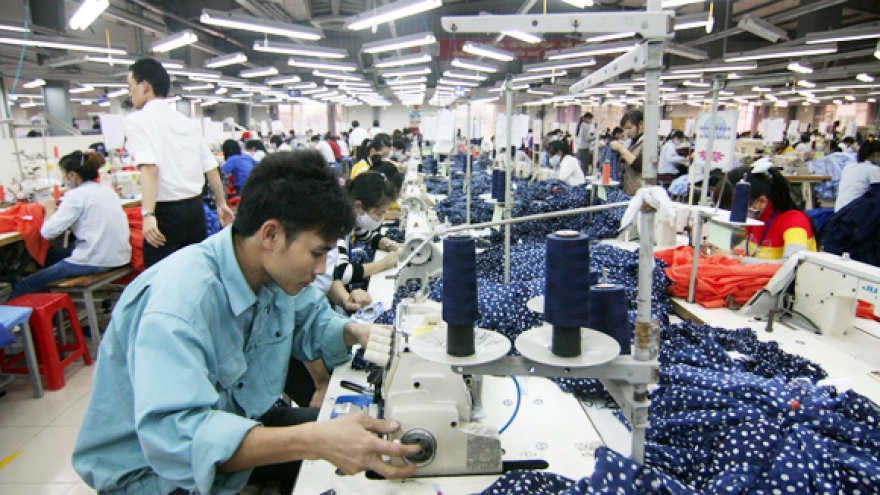Clothiers face hurdles to benefit from Vietnam-EU free trade pact
VOV.VN - A free trade agreement expected to come into force by 2018 holds great potential to boost retail sales of clothing, footwear and textiles produced in Vietnam in the 28 member countries of the EU, say trade experts.
 |
The retail sector in France has an acute interest in Vietnam, said Guillame Crouzet of the Chamber at the conference.
French retailers are interested in Vietnam as a growth market for retail establishments, he noted, and they also view the Southeast Asian country asone of their top three largest sources of clothing, footwear and textiles. In addition, they view Vietnam as a good source of fast moving consumer goods.
EU retailimports of consumer goods are set to get a possible boost from the elimination of tariffs under the free trade accord, which could lower their import tariffs, raising Vietnamese competitiveness with Chinese goods, he added.
Nguyen Thi Tuyet Mai, adirector of the Vietnam Textile and Garment Association in turn also noted the decrease in tariffs potentially could boost Vietnamese competitiveness with China as well as neighbouring Cambodia and Myanmar.
Tariffs levied on Vietnamese imports of consumer goods currently average 12% as compared to no tax levy on comparable imports from China, Cambodia and Myanmar, Ms Mai noted, so all things being equal this should be beneficial to trade.
However, Ms Mai cautioned, the full elimination of the tariffs will be staged over seven years.
There are also strict rules of origin conditions imposed for goods such as garments that will require the use of fabrics produced in Vietnam, with the only exception being of those produced in the Republic of Korea (ROK), another free trade partner of the EU.
Given that many Vietnamese companies source their raw materials and intermediary goods from China, they will not gain any advantage from tariff reductions unless they change their operating methods and import these items from the ROK or another qualifying trade partner.
Another consideration is the fact that many Vietnamese producers will not benefit because they do not pay tariffs in the first place. Many small companies in the industry sell their goods cash on delivery in Vietnam (most often referred to as FOB shipping point).
Therefore, they pay no tariffs, and will obviously not receive any benefit, underscored Ms Mai. Neither will the EU buyer receive any tariff reduction advantage because they are not the producer and therefore do not qualify for such relief.
If Vietnamese producers change their method of selling to ship product to the EU and have the buyer take title to the goods at the destination (technically referred to FOB destination) then both parties would benefit from the tariff reductions.
The Vietnamese producer would not pay tariffs in this scenario because they are the manufacturer and importer into the EU and no tax would be levied on the buyer because title passes in the EU.
This change is not as easy as it sounds and may in many cases not be practical, Ms Mai emphasized, because shipping costs, insurance against risk of loss or damage while the goods are in transit, inspections upon receipt of goods and payment methods all become more complicated.
But this is obviously a viable and in many cases a preferable option for medium sized or larger domestic manufacturers. It could also be practical for all businesses if there was an industry wide revamp.
Another alternative is for Vietnamese producers to change the status of their contracts from that of being a contract manufacturer to that of becoming an outsource contractor for the EU buyer.
This is a common mode of doing business in countries like Taiwan. Technically the term original design manufacturer (ODM) or original equipment manufacturing (OEM) are used, but substantively they are outsourcing contracts.
It is widely estimated that Taiwan manufacturers produce 95% of all their computer components and parts using this type of contract, and in many instances, do so specifically to take advantage of reduced tariffs and other benefits of trade agreements.
In a nutshell, a ODM contractor is a private label contractor making branded products that belong to others. The Vietnamese brand goes away, as well as the Made-in-Vietnam label.
A Vietnamese ODM producer would be responsible for designing and building a product as per another company’s specifications. They do not design and produce a product per their own specifications.
An OEM would refer to a Vietnamese company that is responsible for designing and building a product per its own specifications, and then selling the product to another company in the EU that is responsible for its distribution.
Like the ODM the Vietnamese brand and the Made-in-Vietnam label go away and the products are marketed by the buyer under its own brand name. Both OEM and ODM can be quite confusing and local companies must take great care and time to understand them thoroughly, said Ms Mai.
However, the point that Ms Mai was trying to stress was that the clothing, footwear and textiles segments of the economy will not automatically benefit from the Vietnam-EU free trade pact. If they do nothing there will most likely not be any advantages at all.
Domestic companies must seize the initiative and restructure to gain the fullest advantage from the agreement and overcome the obstacles it presents to elevate their global competitiveness in the high-end segments of the industries.
The Vietnam-EU free trade pact was concluded on December 2, 2015. Final signature is expected in early 2017 with entry into force by 2018. The agreement will eliminate 99.8% of duties on trade products gradually over a 10-year period.
Combined commercial trade between Vietnam and the EU was over US$47 billion in 2015 and is set to increase this year.
Ms Mai noted that local businesses need to focus on training high skilled workers, who are capable to do complex jobs, to produce high-end products.



